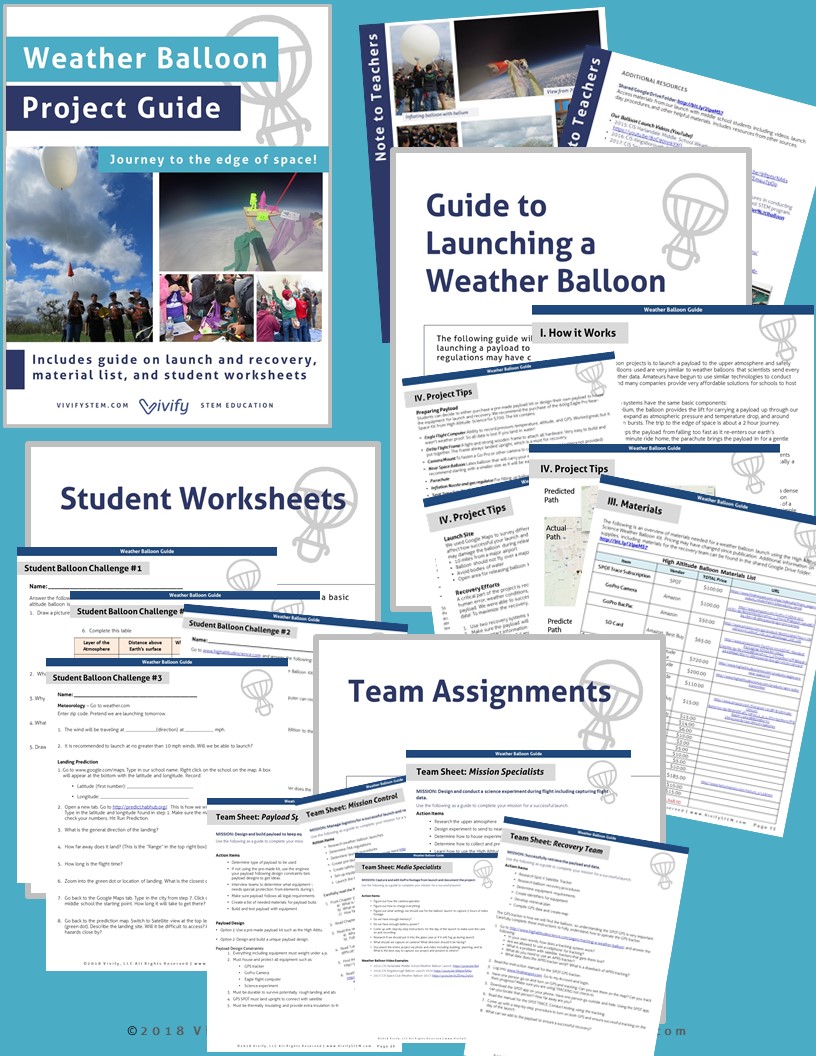Weather Balloon Launch: An Introduction
Post by Natasha Wilkerson
January 25, 2015
What can be more exciting than launching a balloon into near-space and seeing footage of the Earth from above? In a series of posts, I will chronicle the adventures of 2 science teachers, 1 aerospace engineer (that's me!), and 50 middle school students in San Antonio attempting to launch a balloon and payload over 100,000 ft! As a first time adventure for all involved, this has been an exciting, engaging, and frustrating experience managing the logistics of launching along with the attention span of middle-schoolers! Above all, it has been a worth-while journey for students to experience a real-world engineering project with all the design challenges and failures along the way. Read on for our adventure to the edge of space.
Introduction to High Altitude Balloons
The goal of high altitude balloon projects is to launch a payload to the upper atmosphere and safely return it back to earth. The balloons used are very similar to weather balloons that scientists send every day all over the world for weather data. Amateurs have begun to use similar technologies to conduct their own balloon launches, and many companies provide very affordable solutions for schools to host their own balloon launch.
All high altitude balloon launch systems have the same basic components:
Balloon - When filled with helium, the balloon provides the lift for carrying a payload up through our atmosphere. The balloon will expand as atmospheric pressure and temperature drop, and around 80,000 - 130,00 ft the balloon bursts. The trip to the edge of space is about a 2 hour journey.
Parachute - The parachute keeps the payload from falling too fast as it re-enters our earth’s atmosphere. After about a 45-minute ride home, the parachute brings the payload in for a gentle landing.
Payload - The payload houses a GPS satellite tracker, camera, and any other scientific instruments and payloads students wish to send to the edge of space. The structure of the payload is typically a lightweight frame or foam-rubber box depending on supplier.
High Altitude Balloons as STEM Education
There are so many opportunities for STEM learning in this project. Students work in teams to understand the science behind the balloon launch, design and build a scientific payload, select the launch site using predictive modeling and weather conditions, launch the balloon, and analyze the collected data. Doesn't that sounds like a real-world project? Just substitute “student” for “scientist”, and this is exactly how scientists in industry and government labs send experiments into the atmosphere!
Because of the multiple aspects to the project and endless experiment selections, students have an opportunity for many areas of learning. An example of some of the STEM topics covered from a balloon launch and experiment:
Science: Changes in atmosphere, Physics of balloon flight, Design of experiment
Technology: GPS satellite tracker, Temperature and pressure sensors, Predictive modeling software
Engineering: Building payload with size and weight limitations
Mathematics: Analysis of sensor data, Impact prediction calculations, Helium calculation
How is that for STEM learning?!
Even better, a balloon launch project can be experienced at various levels depending on time constraints, skill level of students, and comfort of instructor. One possible project may focus on the changes in atmosphere and launch the balloon with a camera and basic sensors. Another project may focus on engineering design, and students can build a more complex payload to host a larger experiment. Teachers can tailor the project based on a current unit of learning or allow students in an after school program to dictate the objectives.
To give you an idea of what can be sent in a payload, here are some examples of possible experiments for a high altitude balloon launch.
Example High Altitude Experiments:
Pictures and videos of the Earth’s atmosphere and curvature
Exposure experiments to items such as seeds and mold
Light and temperature sensors
Carbon Dioxide/Ozone detectors
Solar cell measurements
Latex balloon expansion
Yeast growth
Humidity measurements
In addition to this scientific learning, it is important to note the interpersonal and communication skills students gain through the process. Students will experience the engineering design process from initial conception to final launch with all the failures along the way. Through this experience, students will build their confidence along with strengthening the useful skills of:
Team work
Communication of ideas
Scientific writing
Data analysis
Research
Convinced yet that this is the ultimate STEM project? Next post I will talk about how to we started this exciting project!
Click here to read our other blog post on launching a weather balloon or watch the video below that takes you on a deep dive into the amazing project!
Planning to launch your own weather balloon? Tackle the ultimate STEM project with our all-inclusive classroom guide to launching a weather balloon PLUS links to a shared Google Drive folder with TONS of extra resources! Based on three years of successful weather balloon experience with over 300 middle school students, this guide is everything you need to design a payload, select an experiment, launch, and recover a weather balloon from a 100,000-foot journey to the edge of space!





